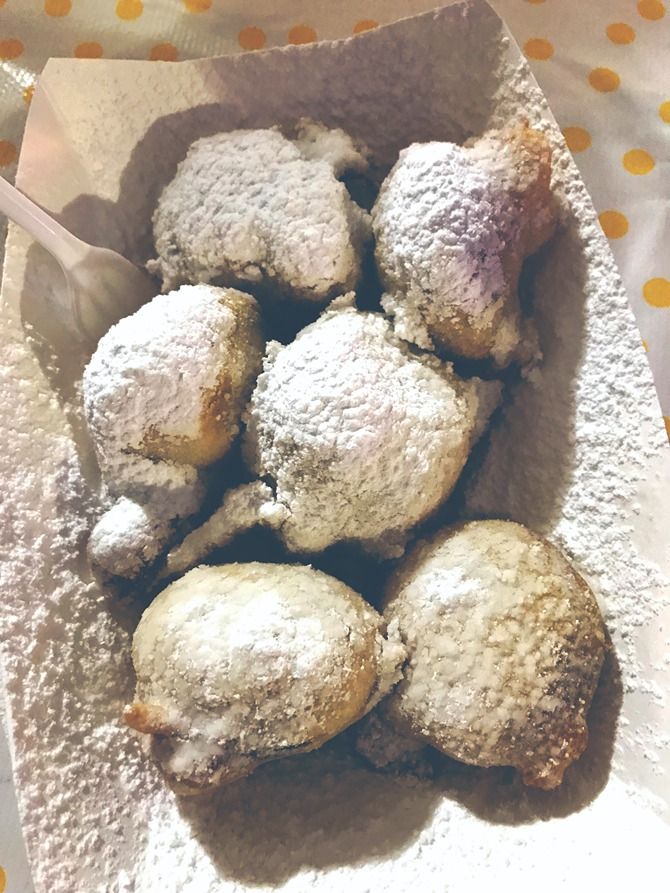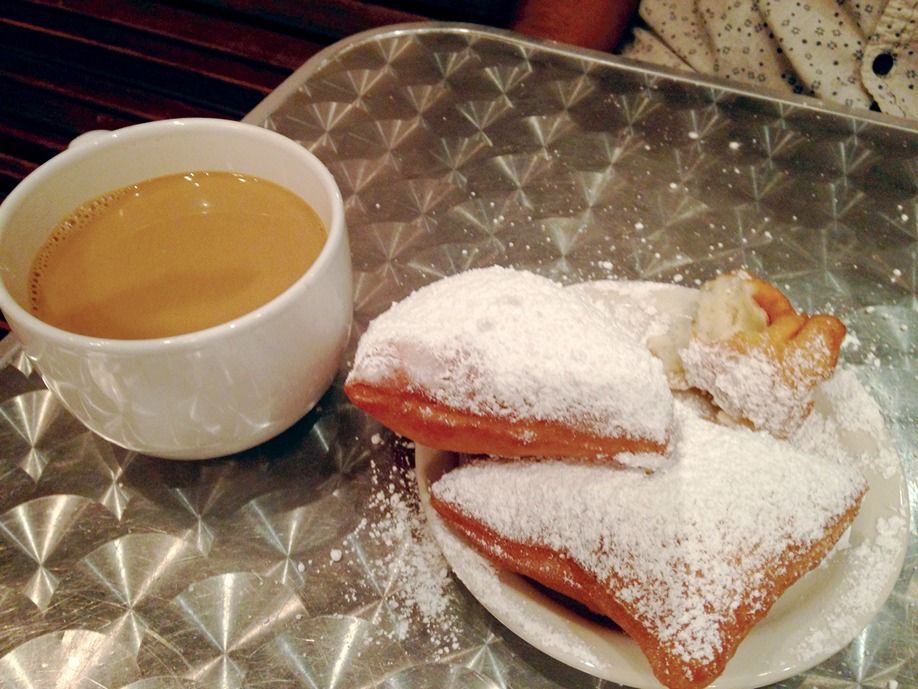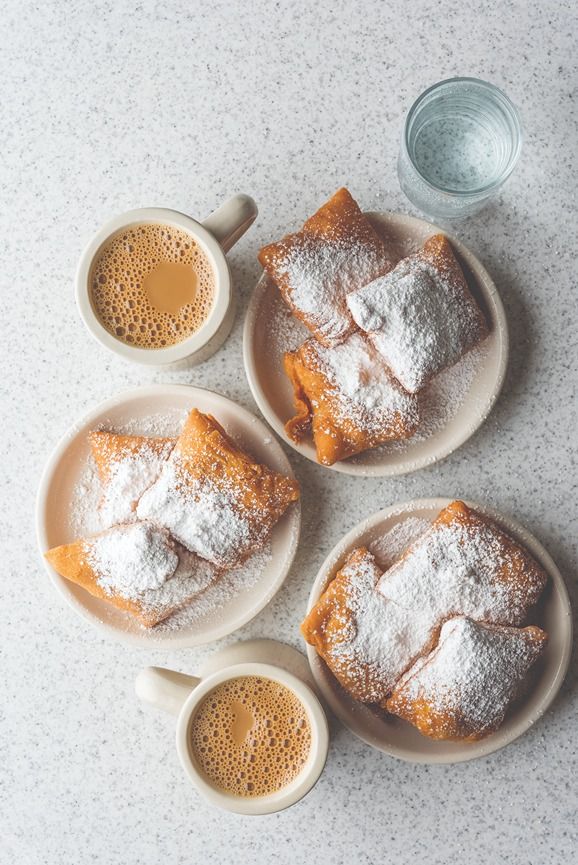Locals have caught on to what tourists knew all along
Underneath the mounds of powdered sugar, there hides a doughy dessert with history, personality, and enough flavor to live up to the hype. Hooray for the beignet.
New Orleans tourists are predictable. Probably at least one in three will ask you for directions to the nearest beignet shop, while the other two will have already figured out where to find it and braved the crowds to go there. You can spot them by the plastic cups full of café au lait they're toting and the dandruff-like sprinkling of white decorating their souvenir t-shirts.
Yet tourists are not alone in their passion for these pastries. Locals are also rather enthusiastic about beignets—proven by the popularity of the annual Beignet Fest, being held this year on September 24 in City Park.
Beignets are an iconic New Orleans dessert—those warm, cushiony hunks of fried dough, piled high with enough powdered sugar to swim in. They're a staple of New Orleans cuisine, our official state doughnut. But what is it about beignets that makes people willing to stand in line for an hour to get a plate of three of them with a cup of chicory coffee?
"A beignet is comfort food, and I think people love it just for that," says Emily Jaeger of Café du Monde. "The beignet has been served along with a cup of coffee since 1862, and it has become part of the fabric of New Orleans."

Powder to the People
Although many locals have their favorite spot, Café du Monde's original French Market location is perhaps the best-known and most frequented beignet shop of them all. It's the oldest, the original, the ringleader.
Recognizable by its green and white awning and the usual line around the block, this temple of beignets at the foot of Jackson Square is like a beacon to carb-lovers and powdered-sugar junkies all around the French Quarter. The smell of fried dough wafting through the air calls them in like the song of the sirens.
First opened in 1862, Café du Monde is a family-owned business nearly in its fourth generation. It has served millions of beignets in its 160-year history and, according to Jaeger, now cranks out thousands daily, with up to 60 at a time in one fell swoop, and in a single fryer.
Eugenie Stevens, marketing manager at Café Beignet, another popular beignet restaurant, adds that they produce a combined total of as many as 36,000 beignets every week at their multiple locations.
This ongoing demand for dough is a testament to how ingrained beignets are in local culture.
The Beignet, Back in the Day
Beignets are French in both origin and name. They came to New Orleans with the Acadians, or "Cajuns," when they first settled in Louisiana in the 18th century. Most experts believe that people have been frying up beignets since at least as early as the 1500s in France. But they could date back even further to ancient Rome—which, in fact, is said to be the birthplace of all donuts worldwide—before the French adopted them as their own.
Beignets may have begun as a rich Frenchman's indulgence, due to the expense at the time of deep frying and the high cost of the animal fat and cookware that would have been used. Nowadays, however, they're a dessert for the masses—masses that may reach as many as 6,000 people on any given day at Café du Monde and 12,000 to 15,000 weekly at the Café Beignet locations.

A Doughnut by Any Other Name
Though the word beignet is usually thought to simply mean "doughnut" in French, it more closely translates to "fritter" and hasn't always been sweet. In France, beignet applies to virtually anything that is battered and fried—perhaps a connection to the ever-increasing diversity of our own local beignets. Not just for dessert and late-night snacks, beignets also serve as appetizers or even an entire meal, and they run the gamut of flavors and fillings—from sweet to savory, crawfish to cream cheese, praline to prosciutto.
The traditional, white-crested beignet remains the standard, however. Those beignets are made with several very basic ingredients: flour, milk, buttermilk, salt, sugar, leavening ingredients (baking powder, baking soda, and/ or yeast), and flavoring. They're then fried, topped with powdered sugar, and doled out to eagerly awaiting doughnut devotees.

Give Me Some Sugar
Aspen, Colombia, and New Orleans—all three of these places are well-known for their white powder. Ours comes in sugary form.
To keep up with the demand for the mountains of powdered sugar needed to top their many beignets, Café du Monde stocks their kitchens with 50-pound bags of the Domino variety and estimates that they go through probably a ton of it every week. That's enough for 11 average-sized tourists to eat their weight in powdered sugar.
Powdered sugar is made by grinding and crushing granulated white sugar into a fine powder and then mixing it with cornstarch. It's light and airy and easily catches the breeze, which means that there's a constant mist of powdered sugar fogging the air anywhere within a one-mile radius of a pile of beignets. Dress accordingly and leave your dark attire at home—there's a reason why Café du Monde staffers wear white.
It's Beignet Great!
There's just something about a beignet, although it can be difficult to put a white, sticky finger on just what it is that makes it so deliciously endearing.
"At Café Beignet, our beignets are handmade and served fresh, hot, and cooked to order," says Stevens. "They have a crispy outside and a soft, sweet center."
It's kind of like a deep-fried hug.

